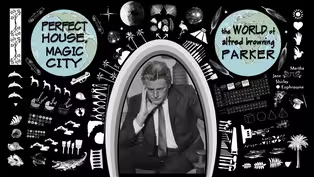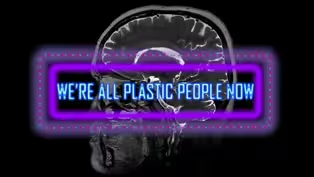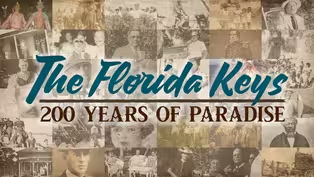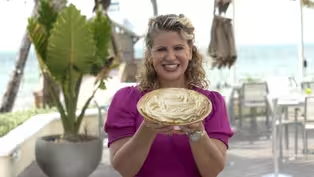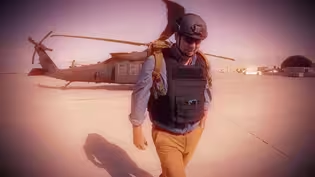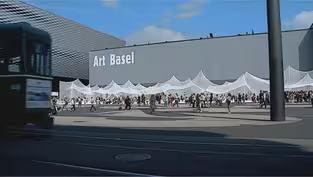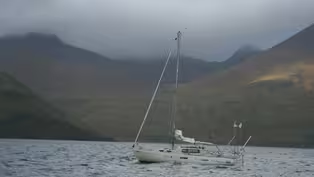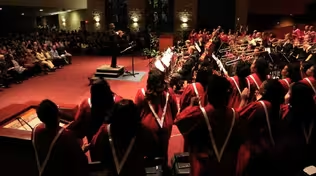South Florida PBS Presents
The Grand Lady
Special | 26m 29sVideo has Closed Captions
The Historic Hollywood Beach Resort, also known as the "Grand Lady," has a famous and stor
The Historic Hollywood Beach Resort, also known as the "Grand Lady," has a famous and storied past. In 1925, founder Joseph Young opened the Hollywood Beach Hotel as the crowning achievement of his new city. From lavish parties and visiting celebrities to a naval training facility during World War II, hear the history, the rebirth and the complicated state of The Grand Lady today.
Problems playing video? | Closed Captioning Feedback
Problems playing video? | Closed Captioning Feedback
South Florida PBS Presents is a local public television program presented by WPBT
South Florida PBS Presents
The Grand Lady
Special | 26m 29sVideo has Closed Captions
The Historic Hollywood Beach Resort, also known as the "Grand Lady," has a famous and storied past. In 1925, founder Joseph Young opened the Hollywood Beach Hotel as the crowning achievement of his new city. From lavish parties and visiting celebrities to a naval training facility during World War II, hear the history, the rebirth and the complicated state of The Grand Lady today.
Problems playing video? | Closed Captioning Feedback
How to Watch South Florida PBS Presents
South Florida PBS Presents is available to stream on pbs.org and the free PBS App, available on iPhone, Apple TV, Android TV, Android smartphones, Amazon Fire TV, Amazon Fire Tablet, Roku, Samsung Smart TV, and Vizio.
Providing Support for PBS.org
Learn Moreabout PBS online sponsorshipMore from This Collection
Documentaries showcasing the South Florida community produced by South Florida PBS.
Video has Closed Captions
A documentary portrait of architect Alfred Browning Parker. (56m 46s)
Video has Closed Captions
Investigation into the hidden story of plastic and its effects on human health. (56m 50s)
The Florida Keys: 200 Years of Paradise
Video has Closed Captions
Journey through the history of the Keys and meet the people who live there. (56m 46s)
Video has Closed Captions
Explore Dr. Anthony Fauci's unique legacy in infectious diseases research. (56m 26s)
Video has Closed Captions
Michelle Bernstein tours the Florida Keys in search of local specialties, recipes and more (56m 46s)
Video has Closed Captions
The story of American men and women serving in our wars in the Middle East. (24m 46s)
Panama Canal: Prized Possession
Video has Closed Captions
Explore the history of the transfer of the Panama Canal from the United States to Panama. (57m 23s)
Video has Closed Captions
Basel, Switzerland plays host to the largest and most influential art fair in the world. (26m 58s)
Video has Closed Captions
Experience the explosion of the Latino influence on mainstream American music and culture. (57m 23s)
Red Dot on the Ocean: The Story of Matt Rutherford
Video has Closed Captions
Matt Rutherford risked it all in an attempt to sail alone around the Americas. (56m 50s)
Video has Closed Captions
Mysteries of the Coral Canyon tells the story of how sharks and coral reefs are connected. (55m 1s)
Video has Closed Captions
Everyone Has A Place is a short musical documentary featuring jazz, gospel and vocals. (26m 55s)
Providing Support for PBS.org
Learn Moreabout PBS online sponsorshipThis program is made possible by the Windover Foundation.
When you got off a train in Hollywood and you looked east, you would see this incredible grand hotel that took people's breath away.
When you want to know what the Hollywood Beach Hotel means to the history of Hollywood, it's really everything.
It is the most photographed image of Hollywood when it was being sold in the twenties.
This grand hotel was built in 90 days from start to finish.
Now, you gotta think about the time frame.
This was 1925 that you could build a building in 90 days of this magnitude.
It had almost 400 rooms and it's made out of solid concrete.
Joseph Young employed lights.
He had floodlights on the property.
He had to erect a tent city to house the workers on the beach.
It happened during a railroad embargo and what happened in the twenties, there was a single rail that served South Florida and South Florida was going under a building boom so many people and goods were coming on the rail that the railroad decided we can't move construction materials because we can't even keep up with the people and the luggage and everything else so we're not moving construction materials this is in the middle of him building this hotel what does he do he commandeers two tankers and sends them to for to Belgium for cement to be brought back to this area and brought up to intercoastal canal and he continues his construction so this entire hotel is made out of poured concrete imported from Belgium.
That's how ambitious the founder of the city was.
He had a job to do and he was going to do it.
He was going to do it quickly and it did open in 90 days.
The architectural style of this particular hotel is Spanish Mediterranean Spanish Morris.
It has a couple of different influences and you really need to look at the beginning of the building to see all the features and details that were on this building.
This tower that you're looking at here, you can see that it's got a kind of a strange shape.
On each corner, it's flattened instead of squared off when the was constructed, the architecture of this hotel was very ornate and elaborate.
There was a lot of external features that have been removed.
On these flattened off corners was a flattened shelf and on each corner of this tower were gigantic statues looking down all in each direction and over the years the gigantic statues were taken off.
There was also mission bells close to this.
There was all kinds of freezes on the outside of the structure gave you something to look at when you looked at it.
It wasn't this bare plain wall.
There was a lot to see when you looked at this.
It's all been stripped off but the flattened corners are still present.
If the hotel is ever restored to its former glory, it would not be hard because that's a solid piece of concrete to put something back there lightweight and bring back that original look.
If you look at the age of this building, it is just under 100 years old.
So over that almost 100 year period, it has been stripped of most of the ornamentation of the outside structure but a couple of elements still remain and if you look in the corner, you can see this concrete freeze or decoration that's coming out from the top.
That's one of the few remaining elements that were part of the outside exterior of the building that made it so grand and and beautiful.
Most all the elements have been removed.
Once in a while, you upon something like that that's just not worth removing or is difficult to remove and there it gets to stay.
Luckily for us because you get some idea of what the rest of it looked like.
This is just a tiny fraction of a piece of everything that was on the outside of this building.
Um it's remarkable that it even is still hanging there and somebody hasn't tried to scrape it off over the last hundred years.
Over half of the population leaves Hollywood after the 1926 hurricane.
You gotta think about that.
We went from 20, 000 people down to maybe 8000 maybe even less than that.
So everybody that had bought lots and land from Joseph Young companies could not pay the mortgages.
So the hotel goes into receivership and a man by Ed Rosenthal and Kaufman and they own the loan on the hotel.
So they actually bought the hotel on the courthouse steps for $500000 dollars.
It can continued in that grand tradition in the 30s the 30s was a whole it was a depression but at this hotel you wouldn't have known it because this hotel was full people were vacationing here it was just as grand as ever people like Eddie Kanter came and stayed here Sophie Tucker Eddie Kanter loved this hotel so much he took up residence here and started broadcasting his show from here on a local AM station he hosted events here so all through the 30s when America was suffering the party was on a Hollywood Beach Hotel.
My mother worked for the Anti Defamation League and her job was to call hotels with two different names.
First, she would call with a very Jewish sounding name.
Hi, my name is Barbara and I'm going to be taking a vacation with my family for Hanukkah, my daughter her family, my husband.
What rooms do you have available?
They would say no.
Sorry, we're all booked up.
Within 22nd, she would call back with missus Smith.
Hi, my name is miss Smith.
Um do you have rooms available?
I'm looking to come for my vacation.
Of course, how many guests will be coming with you?
Uh just me and my husband.
Oh, is this a romantic occasion and anniversary or something?
Yeah, it's our twenty-fifth anniversary and we're looking to celebrate on the 25th through the twenty7th.
You know what?
The presidential suite is open.
So that's how we learned about antisemitism and I remember as a kid seeing signs that say no Jews, no dogs, no blacks.
I can visualize that down in Miami Beach and it was pretty horrible to see as a kid.
In South Florida, there was a lot of anti Semitism and many hotels were what they called restricted clientele which was code word for Gentile only.
The fact that you had a Jewish owned grand hotel meant that a lot of Jewish clientele would come here to stay.
They would return every year.
This hotel was what was on the American plan.
So, if you vacationed here with your family, it was like a cruise ship.
Everything was included.
You didn't have to buy anything.
Breakfast, lunch, dinner, dessert, whatever you wanted.
So, it became quite vacation place for returning visitors.
That also spurred new residents because people came and stayed at the hotel and explored the city and thought, my god, it's paradise down here.
What are we doing up north?
That helped increase the Hollywood population in the depression.
I think we got some influx of visitors because of the hotel and it's it's safe havens so to speak for the Jewish people that weren't allowed because of anti Semitism that was prevailing in South Florida at the time.
In 1942, the war is on and our armed forces are conscripting hotels.
Taking over the hotel and turning into officer Barracks and the golf course as well for training during the Second World War.
This made a great hotel for the navy to take over and it became a naval officer's school after they completed their training.
At that time, there was threat of German U boats and other kind of enemy activity in the ocean so they actually used the tower.
Again, the room that we're sitting in as a lookout at night for any German U boats that could be the waters of South Florida.
This was the tallest building around.
It's 19 42.
There's no other taller buildings in this.
You had really a bird's eye view of all the Atlantic as far as your eye could see.
1945, the war ends and Rosenthal who had his hotel conscripted and no longer could control the hotel decides he wants out of the hotel business and Ben Tobin, a hotelier from up north gets win to this and decides to buy the hotel.
My father ended up winning the bid won the bid and then he had to go scramble to get the money because he he didn't think he was going to win but he won it.
He he won the bid for $a million dollars.
A lot of money in 1945, but two things happened.
The the Navy was going to provide them with money to help restore the hotel.
In the 30s, it was such a grand palace of a hotel and getting people and doing things and fixing the hotel up became quite a monster undertaking.
Him and his family run this hotel and keep the engine going and actually modify it change with the times because you start getting into the 50s and you start getting into the 60s and you see the diplomat hotel being built you see the Fountain Blue you see the Eden Rock and all of a sudden this big Grand Dame Hotel is starting to see a little bit dated so they switch their business model and turn it into more of a convention hotel and it turns into one of the largest convention hotels in the area so it was one of the largest hotels now it's one of the largest convention hotels there's no Fort Lauderdale Convention Center There's no Miami Beach Convention Center.
Now, we have this family has been able to switch gears and let's go forward with another model and make this hotel survive and they did it very well.
This was the largest tourism engine in Broward County in the 50s and the sixties.
The hotel was absolutely elegant.
The ambiance was magnificent.
It was something like out of the movies, out of a Hollywood California movie set.
Everything it was beautiful and they had tremendous amount of staff and there were a lot of kids here Christmas so we made friends we played we were on the beach or we were in the pool they had a beautiful cabana area around the pool and they had activities for us too we still produced the same level of service and the same things that were always done we had people that worked at that hotel that were there from the 30s that came back when they found that my dad was going to do it one of the things I remember the most was going in for dinner or any meal actually three meals a day, there was always ice carvings, breathtaking pieces of art on every food table and they were always different.
Whether you were on the dessert table, there was one.
If you were going and getting coffee, there was another one.
It was really done magnificently and tons of food.
There were 26 bakers, 27 bakers I think in the hotel.
We didn't buy bread, every pastry, every roll, everything was all made there and they were working constantly.
It was a big challenge because we served just so much in so many places.
We had two full-time ice carvers.
People that worked in a box all day long carving ice for parties putting Mia's name in ice.
Putting a planter-looking thing where they could put flowers.
It was so grand that way.
When you checked on the hotel, You never really had to go back to the front desk except it's time to check out.
Your mail was there was a person sitting on each floor and your keys were always there by that person always sitting there on the floor.
They were room service kitchens on every floor and they brought every course to your room at a time.
The original plan of this hotel with Joseph Young was incredible because from downtown when you travel eastbound on Hollywood Boulevard and you're going down that Grand Boulevard, there was a little low bridge that went across the intercoastal and entered you into the formal gardens of the front of this hotel.
There was fountains, there was landscaping, there was palm trees, there was walkways, it was it was gorgeous.
There was actually a mini circle in the entrance mimicking downtown circle.
There's three and this was the end of Hollywood Boulevard and here you have this mini circle in front of this building.
The DOT needs to replace this bridge that Joseph Young built in order to get here in nineteen twenty-five.
The problem with the bridge that he built, it was still structurally sound.
Believe it or not, it had wooden pilings and when they were pulled up to build a new one, they said they were rock hard and had not rotted.
The hotel thing came to an end.
It was a kind of a life lesson for me because we had a deal with the state road department and the Department of Interior about the bridges and they were going to basically take the Hollywood Bridge and they were going to go into between seventh and 8th Avenue and they're going to move the intercoastal over to the middle between those two things creating an island.
So the bridge was so low that if you had a rowboat, the span had to open because it was just too low because there wasn't a lot of boat traffic in nineteen twenty-five.
This was not a really wide waterway and not a lot of people had boats.
Here we are in 1971 and the DOT realizes we've got a problem.
We've got a elevate this bridge.
So, to get over the intercoastal with a higher bridge, something's gotta happen.
You either going to have to come into the hotel property or move the entire intercoastal west which the DOT explored.
They were going to eminent domain.
Houses on the intercoastal waterway buy them out, move the entire intercoastal west, have the span further away so it could gently slope down to A 1 A which is right where the Hollywood Beach Hotel sits.
There was a land grab in that neighborhood.
People got wind to this they started to try to buy every house, every stick, every bush they could because they knew the DOT was going to give them a lot of money.
You just can't possibly imagine the rush for land to go buy homes and lots there which they ended up eating because I didn't do that.
DOT realized that was going to be a very costly you know solution to this problem so they decided to eminent domain.
There was talk that they were going to eminent domain in the front of this hotel and Ben Tobin starts to see the writing on the wall and realized it may be a good to sell.
What happened, they changed their mind.
They went off and spent millions of dollars that they didn't have to do.
Ended up in an eminent domain lawsuit taking a third of the Hollywood Beach Hotel property.
Nightmare for us.
Once that bridge overtook the grand entrance, it really changed the hotel forever because you've lost that entrance way.
You've lost that front door.
It was like you just took a knife and stabbed it right into the grand entrance of the hotel and it's lost its feng shui so to speak.
I mean, you know, you can't like go down a ramp and you're almost touching the building.
You just can't run a five-star hotel with a third of its property and a ramp coming off with light shining in the in the windows.
So, gardens would have been lost.
Our so many things we we had there.
We lost.
That was a day we knew we it was time to get out of that business.
We had offered it to the city, okay?
We did.
The city of Hollywood.
They they didn't want it.
A Bible college a small probably little known Bible College operating out of Miami decides this would make a great Bible college what a huge campus for us and they come up here and see this building and they buy it from Ben Tobin so while they own it the DOT eminent domains the property in front they get the money from the DOT and they don't really care because it's not a hotel it's a college so they're not really worried about the grand entrance four of us and two cars drove down in the darkness of Highway 27 and we came travelling east on Hollywood Boulevard and by the time we made it past the Young Circle the first circle we could see the the hotel brilliant white and this golden bronze letters Florida Bible College I grew up in Hollywood and I never step foot in here because I wasn't a bible college student I just remember seeing Florida Bible College on the building and never thought too much about it until I started to get older and I would be sitting on the beach and minding my own business with my friends maybe drinking a beer I don't know and here comes these college students nicely dressed not for the beach mind you with pamphlets trying to save our souls and I'm like what what is going on we were known for sharing the gospel on the beach with beach goers so here's here's here's a picture here's an example of what I would do when I was here you just approach people and you talk to them and either they kept listening as they said thank you and they laughed This is a landmark.
It's just part of history and I can remember so many beautiful places and nooks and corners that we we climbed into and we found and and one time we even came here by train and I remember stopping at the station seeing Hollywood by the Sea on the side of the station and that's where this was.
This was Hollywood by the Sea and it was very very important.
And this is one of the views from the second floor, the archway.
I mean, just a stunning view that I compare a little bit to the second floor of the Palace of Versailles.
It it when you look out into from from the hotel to Hollywood, Florida.
It's the same that exist, the city exist because the building started.
The Hollywood Beach Hotel was a centerpiece on the smorgasbord that was Hollywood okay it was that focus it it brought people of considerable wealth and power into the place oh here's President Gerald Ford 1975 so we had some politicians some well-known politicians come so we weren't a we weren't a closed community at all you can take things away history is is the best teacher because if you don't learn about it that Kennedy said that then you doomed to have history repeat again in my view you do everything you can to preserve things you you don't over you don't over bear on it I hope that one day there's a way to rectify this wrong maybe there is I mean Elon Musk is going to build a tunnel under the river perhaps we can have our own tunnel here under the intercoastal waterway and save the front of this building the best example I can send you to.
Once this all settles down is go down and take a look where the surf club was.
There's two, there were two famous restaurants in it, okay?
And there's a hotel that's so modern full of glass and they saved this 1925 or 30 building and down and it's a one-story building and when you walk in there, you're going to think you were in the 30s.
What we did there specifically at the surf club is we took the DNA of the original building and expanded it and made it open to the public.
People always wanted to know what's going on in the surf club.
Now, anybody can walk in whether it's from Collins Avenue or to the walk along the ocean and they can see they can have a cafecito in the morning, they can have a drink at night, they can go to the champagne bar, they can go to the Thomas Keller restaurant, they can go to the Lido restaurant, they can actually see, feel, and touch the historic spaces and surfaces around them which I think is a very important gesture to do because then it gives you a different feeling.
It creates a certain value to the development.
The modern additions in the modern buildings are nice and they are designed on a space plan stepping back so as you drive north and Collins Avenue the low rise historic med revival structure is in the foreground like the crown jewel and the larger structures are stepping back same thing on the ocean when you walk along the ocean you'll see that they're stepping back and they're like welcoming arms so that you see what is the crown jewel you see what is the pinnacle of the development which is the historic structure the historic and that's what the story is about.
I just believe in keeping the old.
I don't I think there's a history there and which even you go back to New York City, you see the brand-new steel buildings and everything where they busy tearing down.
When you go to Europe, they've maintained all the beautiful buildings and it's a treasure.
It's interesting to be part of that.
So, I think that that rich history is symbolic of how it is that you can create good design and add on to it and build upon it.
It's a building upon the show of our forefathers and foremothers.
I think that that creates as a designers, an architect, a DNA, a lexicon of architecture and design which is above and beyond what you would do if you were to demolish it, right?
Um or completely going to another direction and this is something that I've enjoyed in doing and not only the surf club but if you look at the courthouse in Tempa it was a historic courthouse who was closed for decades and we opened that up as La Meridian Hotel by converting the existing courthouse and recycling the uses into the new modern uses.
We did the same thing at Miami Beach in the historic district in the historic district of Miami Beach.
We did the Caribbean condominium.
We come into the Caribbean condo.
We all use the beautiful Torazzo lobby with the beautiful streamline design with the black stone wall and we penetrate that beautiful lobby and go wow and you see the ocean but then it leads you into the new modern twenties building a a 200-foot building immediately adjacent to it that modern design modern glazing design adjacent to the traditional a masonry is how people can tell oh this is was original and this is the new building and they're complementary but they're different you know it's like you use the DNA of the people who came here before you yet at the same time we want to make sure that we represent truthfully what we are today and by using the the historic spaces by using the historic architecture the historic design telling the story whether it's the Caribbean or the courthouse in Tempa or the surf club or even Cadillac Hotel which was done by Roy France we added on to it we made it into a Marriott Hotel and it started as a courtyard but really over the years it became such a draw that they decided to make it into the next level high which is the Marriott autograph which it is now in Miami Beach and those of typologies of where it is that you can use the historic spaces and restore the terrazzos.
I mean the surf club we restored all the wood, all the ceilings, all the details in the ceiling.
Even on the floors when you walk on Peacock Alley and you have a tile floor with black tile Jewish stars on it that you walk on.
We restored all of that.
We brought it back to its original design and layout.
We wanted to maintain that and build upon it into the next spaces.
So when you come into the next building you have stone and you have big slabs of terracotta big slabs of limestone and travertine that then blends in and ties to the original stone and materials that we had in the building.
The historical society is not anti-growth to be like, oh you guys want to save it?
We don't.
We're pro smart development while preserving your historic inventory.
They're called historic resources for a reason.
They're the resources of the city and they tell our story and if you don't have them, you might as well, you know, not not anything against Weston or Pembroke Pines but just go out there they they're going to have history one day but right now they don't we have it we're a pioneer city like Coral Gables or Miami Beach Hollywood is one of the few planned cities in South Florida this city was laid out by one guy Joseph Young and that's what also makes it special and that's what makes this building special because they're positioned within the grid to give you a wow factor that's why this building has such a prominent spot on Hollywood Boulevard that's why the circle ends right there and it's in the center of town we have a 10 acre park in the middle of our downtown so all the development going on around there they get to use that park it's all part of the city beautiful which is what our founder built this city on that concept was public access that's why we have a broad walk in front of this hotel no other city or coastal community in Florida has a two mile long road walk we have the two beautiful lakes that have public access so I'm passionate about Hollywood's history because it's my hometown and I don't want to see it erase and a lot of people don't want to see it.
You This program is made possible by the Windover Foundation.
Support for PBS provided by:
South Florida PBS Presents is a local public television program presented by WPBT
